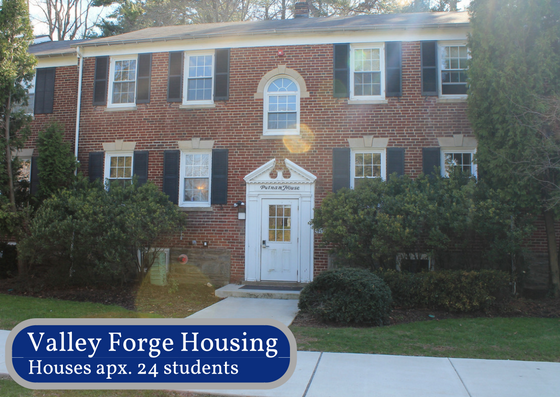Recently announced changes to the housing process for Cabrini students have left many concerned about their chances of living on campus, or if they will now have to relocate and find their own off-campus housing before the fall semester begins.
This is the time when students are typically thinking, “Who will I live with? What residence hall should we choose? Who gets the single room? How will we rearrange the furniture?”
But this year, those questions turned into confusion because of new housing changes that quite literally flipped the process upside-down. With changes to the selection process, new residence hall options and a substantially growing student body, students are now instead working to figure out if they will still have the chance to live on campus next year and if they can afford the off-campus living situation if not.
“It will be a continued problem because the class sizes are getting bigger, which isn’t the worst problem to have. But at the same time, as a small school there’s only so many places you can put these people so Cabrini has to do something about it… but I don’t know what the solution is,” Brandon Weaver, a junior marketing major, said.
Graphic designed by Cecelia Heckman, information based on Resident Hall estimates on cabrini.edu.
Students are angry and upset
In order to try to fit as many people as possible in the campus residence halls, the Resident Life department decided it was time for some changes in the housing selection process.
“As we are progressing with our larger classes it is just time now to change our system,” Sue Kramer, director of Residence Life, said.
One of the most debated thus far by the students was the flip in housing selection times. Traditionally housing was first chosen by the seniors, then juniors and then sophomores. However, that process is now being reversed. The first to choose will be the upcoming sophomores, then the juniors and so forth.
With the thought that it may come to the point where some students could not be guaranteed housing for the following year, it was decided that this process would be the best way to fairly be sure the younger and newer students could definitely have a place on campus.
“Philosophically, if we did run out of housing, seniors would be ready to move off campus,” Kramer said. “But our goal is to house everybody and it has always been to house everybody. But if we would run out of housing, seniors developmentally are ready to move off-campus over a sophomore at 19. So we reversed it, that is why.”
Some students have not been happy with this decision, though many do see why it would have to come to this.
“I understand why they would say that but at the same time I still think if I want to as a senior I should still have the option to live on campus, whereas I feel like it’s just they’re just nudging us off campus at this point,” Weaver said.
Many students are even worried about the logistics of what they would have to do in the future if they were not able to get the housing on campus that they were hoping for. They fear that looking for alternative housing options off-campus are unrealistic at this point.
“In other schools you see that there’s [more] options whereas we’re on the Main Line so it’s really not realistic to find housing over here so it’s a little harder,” Weaver said.
Junior psychology major Emely Gutierrez left her home of California to come to school at Cabrini. Since day one, she was never worried about not having an option for housing. But now, she is worried that she may struggle.
“I’ve never had to worry about this and suddenly I am going into my final year and I’m told two months before the school year is over that I’m not guaranteed housing,” Gutierrez said. “I know it’s common at a big school, but the students are told that from the beginning that they only have so many years of guaranteed housing. It’s definitely asking for some major flexibility from the upperclassmen and their families.”
Originally, some student Residence Assistants informed their friends of the new situation before there were any confirmed emails sent out. That raised alarm to many students who heard the rumors that seniors would be kicked off campus next year.
“I did hear the rumors before the email was sent. I was a mess. I was like ‘oh my goodness I’m going to [have to] live off campus,’” Gutierrez said. “I know a lot of the time you need a parent to cosign [for an apartment] and the school year is almost over, so I have very little time to put down or find a place for next year.”
Gutierrez, like many students who live far from campus, are nervous for how the selection process will be carried out.
These nerves are not unwarranted, especially with the location of Cabrini’s campus in a wealthier area. According to Salary Expert, the cost of living in Radnor, Pa., is 16.4 percent higher than the national average.
Main Line Student Rental, an apartment community located in the Wayne, Pa. area, works to provide off-campus, reasonably priced housing for students. However, their costs can range anywhere from $525 to $4500 per month depending on the apartment type. Similarly, Cabrini’s website offers suggestions for local off-campus housing options that also start off with pricing around $500 a month.
“When the day comes to pick housing, if I don’t have a place [to live], I don’t really know what I’m going to do. I’ll have to look for a place, find the means financially, all while working, keeping up with classes and keeping all my roommates’ needs in mind as well,” Gutierrez said.
Sophomore Effie Soldatos, an elementary education major, feels as though this will not mess up any of her plans for this year (and even helps her chances of getting into the Apartment Complex). However, she worries for what her future will hold when entering her senior year.
Her concerns are mostly based on the fact that she does not and will not have a car in the next couple of years. In this area, it is almost required to have a car in order to get to campus, or be able to get to the Radnor SEPTA line from your housing. Main Line Student Rental states that the Wayne area is a car-dependent area.
“Next year as a senior I feel like it’s going to mess up my housing and I don’t have a car so it’s going to screw me over,” Soldatos said. “As a senior it would be very difficult [if I cannot live on campus] because I do not have a car and I probably will not be able to get a car by senior year.”
What is the Valley Forge housing?
With the fear of not having enough space for all of the students looking for campus housing, the Residence Life office decided to try to provide another option for juniors and seniors, Valley Forge housing.
Located on the opposite end of campus of one of Cabrini’s neighbor schools, the Valley Forge Military Academy & College, this is not new to Cabrini’s history in housing. A Loquitur article reports transfer students living there about 11 years ago as well.

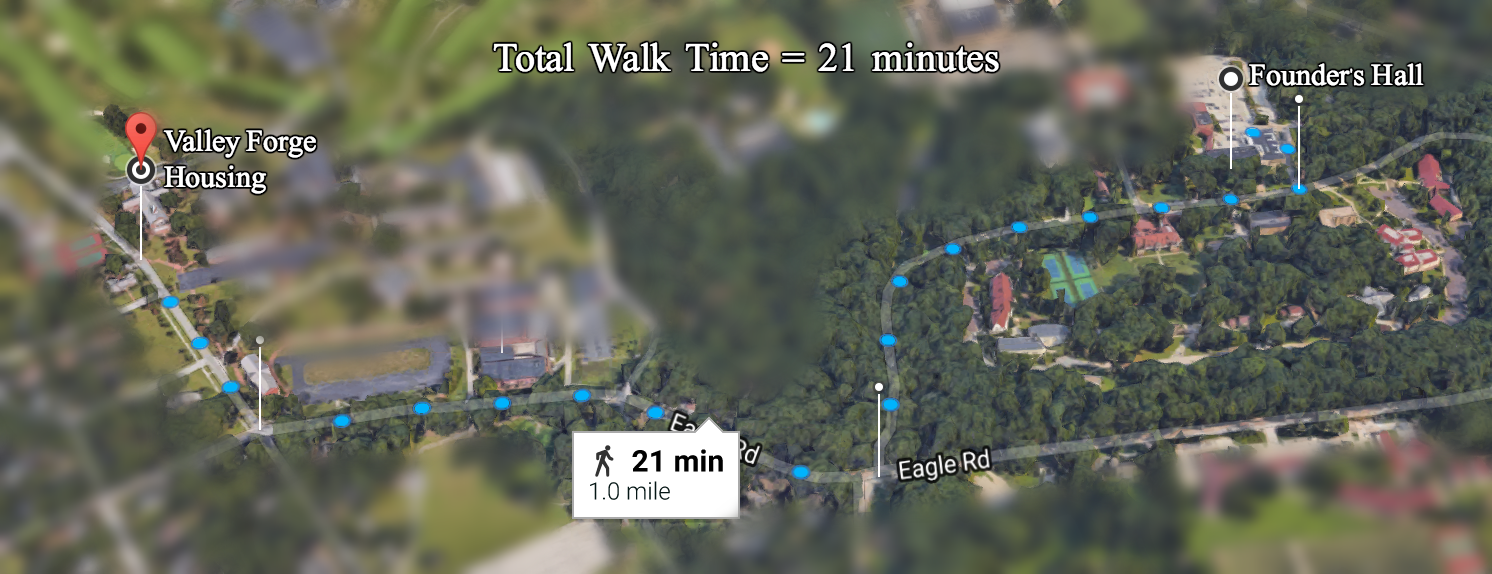
Kramer said that it has been about eight years since this housing has been used, for lack of necessity. However, now with the increasing enrollment it has once again become an option that will be available for 24 Cabrini juniors and seniors, including two RAs.
Located on Radnor Street Road, these apartments are set up with two bedrooms: a double and a single, fitting three students per apartment. According to an email sent to all students about housing, the apartments will come fully furnished and include a kitchen and bathroom. Pricing will be the same as the Cabrini Apartment Complex.
“This is an opportunity for a different type of student,” Akirah Massenburg, assistant director of Residence Life, said. “Because they do not have to have a meal plan at the Valley Forge, that can help students who might be looking at their financial situation. If they don’t have a larger group of friends that they want to live with, they only need a group of three. Those are the perks of it.”
It is also recommended that all students who choose to live in the Valley Forge housing have a car. At this point, the school is unsure whether they will add this housing to the shuttle stops as an option for transportation. All of these students will be able to apply for a commuter parking pass, though they will still be considered resident students by Cabrini.
At this point in time, not too much information about the Valley Forge housing option has been released, aside from the basic amenities listed in the email sent to students.
“I really can’t form an opinion because they’re not giving us enough information about this,” Weaver said. “So if we had more floor plans, we got to see the pictures of these houses, I could give an opinion.”
This Valley Forge option is part of the same set of buildings that Eastern University currently uses to house some of their students as well. Eastern calls this area “The Village,” and for them it currently houses graduate students and students over the age of 23, according to their website.
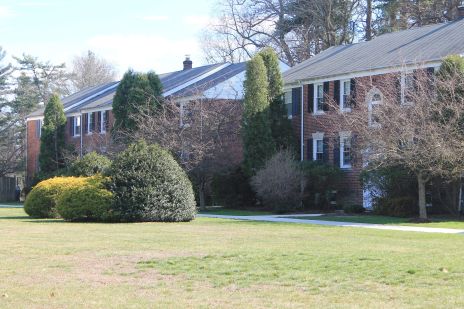
The house which Cabrini students formerly lived in was the Putnam House, part of “The Village.” However, it is not yet confirmed if this house will be one of the two housing Cabrini students next year. Neither of the buildings’ names have been released yet.
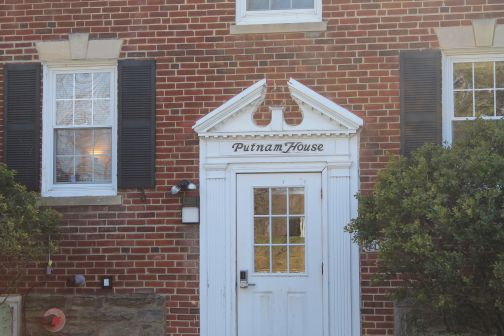
Cabrini’s enrollment is still growing
Over the last few years, Cabrini’s enrollment has been continually increasing, unlike many other similar local schools. While this is a positive for the school as a whole, it also leads to necessary changes based on the greater need for space for all of these larger classes.
Each year, the department of Residence Life reevaluates where the campus is at in terms of fitting the students into the residence halls, then run the information by Dr. George Stroud, the assistant vice president of student life/dean of students.
“We evaluate what we are doing, where we are going, how many beds we are going to allocate for each class and for each building,” Kramer said. “Our goal is always to house as many students as possible.”
This past school year, 61.5 percent of undergraduate students live on campus. This is around the typical yearly amount who live on campus, which according to Cabrini’s website tends to be around 60 percent.
This past year, the incoming freshman class for Cabrini was far larger than recent classes. Currently their body of 446 students accounts for 30 percent of the entire undergraduate population.
Next year, if the incoming class is exactly the same as it is currently, there will be 1,638 total undergraduate students on campus.
With this growing student body in mind, only a small increase in the incoming class could create an overflow of the number of students who want to live on campus versus the number of beds that are available.
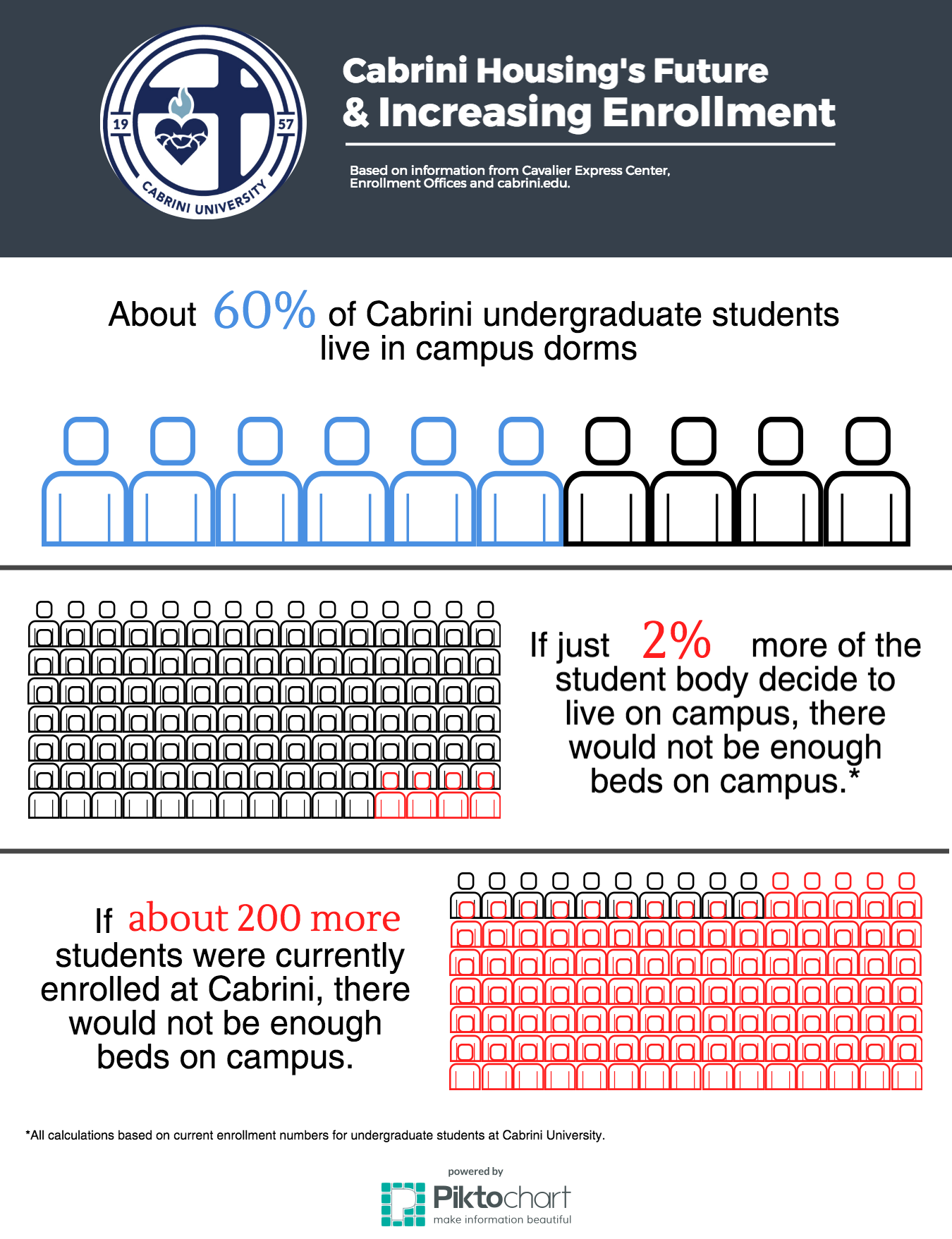
For example, if just two percent more of the current undergraduate students decided to live on campus rather than commute, there would not be enough beds within campus housing for every person. If Cabrini had accepted roughly 200 more students for this current 2016-2017 school year, and the typical 61.5 percent wished to live on campus, the same problem would occur.
Realistically, the odds of this happening in the upcoming years are not too far out of reach. Bob Reese, the vice president of Enrollment Management, confirmed that the incoming class size is expected to be just as large as last year, though of course there are many variables that could still come into play to affect this.
Factor in also that Cabrini just held its largest Accepted Student Day in recent history, and this year hired a new admissions counselor solely dedicated to recruiting transfer students, there is a reasonable chance that enrollment will be not only matching but increasing when compared to this past year’s incoming class.
Some changes are being overlooked
Despite the fact that the new housing selection process was altered and students fear the change, there were many other changes that students may be more excited about.
Each year to be guaranteed housing on campus, each student had to pay a $200 deposit, and for this past incoming freshman group, a $300 deposit. If the deposit was paid on time, that meant that students were able to get a lottery number and participate in the housing selection.
This year the process has changed. There is no more deposit. Students do not have to pay to participate in the selection, but they do need to be registered for classes to show that they are definitely coming back next year.
“We have implemented that the students have to be registered for class and I think that is really important and a key part to this process that no one is talking about. That is a really good opportunity because sometimes we have students who apply for housing that didn’t sign up for classes and a part of living on campus is that you have to be registered for class,” Massenburg said. “I think that may also assist people in motivating them to get everything in order so that they can be ready to be living on campus.”
Residence Life has offered six information sessions that were open to concerned students who wanted to know more about the changes to the housing selection as well as the housing process.
Small groups of both upper and underclassmen attended the meetings that were offered in the different residence halls. They expressed their feelings towards the new housing options and asked their many questions on how the housing process works.
“It is important that people come with their concerns and talk to the professional staff members so that they are getting the right information,” Massenburg said.
At the sessions was a PowerPoint presentation that explained the steps a student has to take to be eligible to participate in selecting a room and roommates, as well as what living options they have available to them.
With the change, each year is now sectioned off to live in certain buildings, similar to how it has been done before.
Now, rising sophomores will have the housing options of living on the first floor of East Residence Hall or in one of the seven houses that are on campus.
Rising juniors and seniors are now restricted to only picking housing in West Residence Hall, Cabrini Apartment Complex or the housing offered at Valley Forge.
“[The process has] changed, it’s new, it’s scary and that is always scary,” Kramer said. “I think we are looking at this as a positive thing for our students and the population to house the students that want to come back to Cabrini, that will be coming back to Cabrini.”
For further information on the housing changes, contact the Residence Life office at reslife@cabrini.edu.

